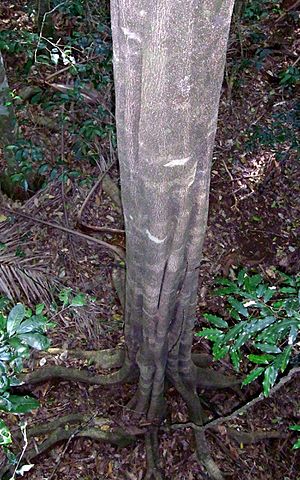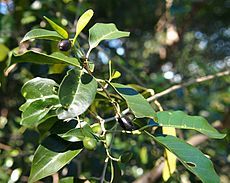Native olive facts for kids
Quick facts for kids Native olive |
|
|---|---|
 |
|
| Tree at Sea Acres National Park, Australia | |
| Scientific classification | |
| Genus: |
Olea
|
| Species: |
paniculata
|
| Synonyms | |
The Olea paniculata, also known as the native olive, is a type of tree. It belongs to the same plant family as the well-known olive tree. This tree grows naturally in many parts of the world. You can find it from Pakistan and China all the way to Australia and Pacific islands like New Caledonia.
Contents
What is the Native Olive?
This tree often grows as a bushy plant. It can reach up to 30 meters (about 100 feet) tall. The trunk has smooth, grey-brown bark. It can grow up to 90 centimeters (about 3 feet) wide. Sometimes, the base of the trunk has special wide roots called buttresses.
How to Spot It
The leaves of the native olive are shiny green. They are shaped like an oval or an ellipse. They are about 5 to 10 centimeters (2 to 4 inches) long. They are also about 1.5 to 6 centimeters (0.6 to 2.4 inches) wide. The end of each leaf comes to a sharp point.
The fruit of the native olive is blue-black and oval-shaped. Each fruit is about 0.8 to 1.2 centimeters (0.3 to 0.5 inches) long. These fruits are usually ready to eat from May to September.
You might confuse the native olive with another tree, the African olive. However, the native olive has tiny dips between the main and smaller veins on the back of its leaves. The African olive does not have these dips. The African olive is also often found in places changed by humans, like roadsides.
Naming the Native Olive
A scientist named Robert Brown first described this tree in 1810. He gave it the scientific name Olea paniculata. This name is still used today.
People call this tree by several common names. These include "Australian olive," "pigeonberry ash," "maulwood," and "clove berry." In China, it is known as 腺叶木犀榄 (xiànyè mùxī lǎn). The second part of its scientific name, paniculata, comes from a Latin word. It means "tuft," which describes how its flowers are arranged.
Where Does It Grow?
The native olive tree grows in many different places. In Australia, you can find it from North East Queensland down to the Hunter Region in New South Wales. It often grows near rivers and streams in dry rainforests.
Outside of Australia, it lives in China's Yunnan province. There, it grows in wet, sheltered valleys high up in the mountains. It is also found in countries like India, Indonesia, Nepal, Pakistan, and Sri Lanka. You can also see it on islands like Lord Howe Island, New Caledonia, and Vanuatu.
Native Olive's Animal Friends
Many animals enjoy eating the fruit of the native olive. In Australia, several birds feast on them. These include the Australian king parrot, brown cuckoo-dove, and topknot pigeon. Rose-crowned fruit-doves, wompoo fruit-doves, and white-headed pigeons also eat the fruit. Even the green catbird and regent bowerbird like to snack on them.
Why Is This Tree Important?
The native olive grows quickly in sunny, protected spots. It needs soil that drains water well to grow strong. Its black fruits are a favorite food for birds, which helps spread its seeds. This tree is also a host plant for certain butterflies.
Long ago, Aboriginal Australians traditionally ate the fruit of the native olive.


